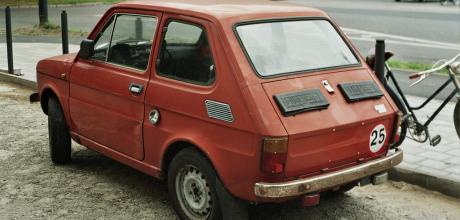1969 Steinwinter 250
499cc engine too big for you? One company would merrily swap a 250cc lump into your baby Fiat. But why? Story by Chris Rees.
Everyone loves the Fiat 500. No bigger than it needs to be, it’s the essence of basic motoring. Surely no one could ever say it was overpowered, though. For most of its life, its 499cc engine had all of 17hp, and even in final 500R guise with a 594cc engine, it only had 18hp.
But in Germany, a company found a way of shrinking the engine and making the car even slower. What on earth could be the reason? Because there remained a sizeable number of older drivers in Germany who had only ever obtained an archaic ‘Class 4’ driving licence, intended for vehicles with a maximum engine size of 250cc (a test the authorities had dispensed with in 1954). Such cars proliferated in early post-war years: the BMW Isetta was one, while the Goggomobil was another, the latter boasting a 245cc engine.
The ‘Goggo’ left production in 1969, leaving a gap in the market that Manfred Steinwinter of Stuttgart realised he could plug. He founded Steinwinter Automobile and adopted a logo that was a dead ringer for Ferrari’s prancing horse badge (although he insisted it was derived from the rampant horse on the flag of Stuttgart, not Maranello’s).
In 1969, the company started to install sub-250cc engines into Fiats, with the target market being that ageing ‘Class 4 licence’ clientele. The engine chosen for the new Steinwinter 250 was the 245cc two-stroke air-cooled unit borrowed from the old Goggomobil. Developing a claimed 15hp (in reality more like 13.6hp), it was hardly a powerhouse: a top speed of just 56mph was claimed.
The powerplant looked utterly lost in the 500’s engine bay and it certainly didn’t do the environment much good with its oil-burning two-stroke format. Apparently the engines were manufactured by a company that had assumed the tooling for the old Goggomobil motors.
In time, Steinwinter also performed the same conversion on Fiat 126s, with a model called the 250L or FiGo (Fiat- Goggomobil). The company also built a version of the Panda with its top speed limited by the simple expedient of locking out third and fourth gears!
Steinwinter’s production was sporadic, with the very last conversions being done in around 1987. Most of its converted Fiats only did low mileages but even so, when their aging owners decided to sell, the cars were virtually worthless. Some still exist, although many have been converted back to Fiat power.
Steinwinter also had a side-line in importing models from small Italian manufacturers. One was the Amigo, made by Auto Mirage of Bologna. This was based on a Fiat 126 platform with bodywork in glassfibre, and was offered until 1982. Another was the Steinwinter Junior, an imported Allcars Charly 50cc microcar.
As a coda to our story, we should mention that the Rome-based tuner Giannini also made a smaller-engined version of the Fiat 500 called the 350 Economy Run, achieved by reducing the 499c engine’s stroke to 46mm to obtain a capacity of 390cc. This happened in 1974, at the height of the oil crisis when fuel economy was top priority. Unsurprisingly, it didn’t last long.


